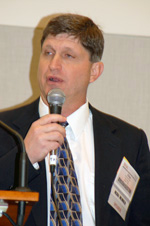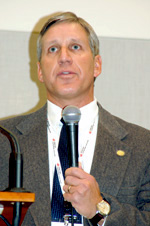Cost Management Strategies
PHOENIX, Ariz. (Jan. 28, 2009) — During the 2009 Cattle Industry Convention, one of the best-attended Cattlemen’s College sessions offered insight to the cost-control strategies applied by successful managers from the cow-calf and cattle-feeding segments. Explaining their respective approaches to managing rising input costs were Chip Ramsey of Nebraska’s Rex Ranch and Tom Brink of Five Rivers Ranch Cattle Feeding Inc.
 Chip Ramsey Ramsey said the basic systems for managing the Rex Ranch’s cow-calf and yearling enterprises were in place when he became manager in 2006. He credits those systems for positive trends in pregnancy rate, weaning rate and average weaning weight. However, the cost per weaned calf is also trending higher. He is looking at the areas of greatest cash expenditure — labor and feed — and searching for opportunities to trim costs.
Chip Ramsey Ramsey said the basic systems for managing the Rex Ranch’s cow-calf and yearling enterprises were in place when he became manager in 2006. He credits those systems for positive trends in pregnancy rate, weaning rate and average weaning weight. However, the cost per weaned calf is also trending higher. He is looking at the areas of greatest cash expenditure — labor and feed — and searching for opportunities to trim costs.
Seeking efficiency of labor, the ranch employs just one person for every 800-1,000 animals, and strives to provide appropriate compensation, including health insurance and retirement benefits. Ramsey doesn’t see how numbers of employees could be cut further than it has been in recent years and views labor as a nearly fixed cost.
“We’re considering calving even later — delaying the start of calving season from April to May. That should reduce the amount of hay fed during winter, especially for mature cows,” Ramsey said. “We’re also looking for ways to enhance the flexibility of our stocking rate. That way, we may be able to change our cow-yearling ratio, have more drought flexibility and increase our efficiency of (grazed forage) use. We might do that by increasing meadow grazing.”
Ramsey said he is also looking at alternative enterprises such as a wildlife program and marketing of carbon credits.
 Tom Brink Tom Brink said the current economic environment has been particularly challenging for cattle feeders. He called Five Rivers very conscious of where the money goes, with the largest expenditures going toward the purchase of feeder cattle and corn, labor and energy.
Tom Brink Tom Brink said the current economic environment has been particularly challenging for cattle feeders. He called Five Rivers very conscious of where the money goes, with the largest expenditures going toward the purchase of feeder cattle and corn, labor and energy.
“We’re taking a more disciplined approach to buying feeder cattle, and we’re not trying to feed to full capacity,” Brink stated.
As a defense against high input costs, Five Rivers is buying heavier cattle that require less corn to finish. The company is turning to more alternative feedstuffs, including byproducts and increased use of fat in rations.
Another cost-cutting measure is to reduce days on feed. Equipment use is being evaluated, to match the appropriate equipment to each job and conserve energy. Another goal is to reduce the number of employees at 10 Five Rivers’ feedyards from 640 to 600 or less.
Editor’s Note: This article was written under contract or by staff of Angus Productions Inc. (API), which claims copyright to this article. It may not be published or distributed without the express permission of Angus Productions Inc. To request reprint permission and guidelines, contact Shauna Rose Hermel, editor, at (816) 383-5270.

